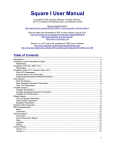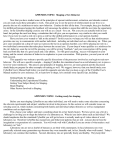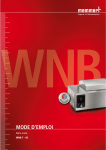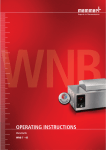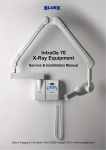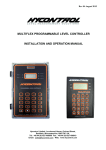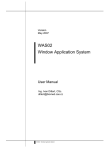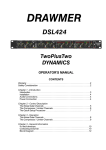Download TOA Electronics 1000 Series Network Card User Manual
Transcript
Operating Instructions GRAPHIC EQUALIZER E-1231 TOA 1000 series THE LIGHTNING FLASH WITH ARROWHEAD WITHIN A TRIANGLE IS INTENDED TO TELL THE USER THAT PARTS INSIDE THE PRODUCT ARE A CAUTION RISK TO REDUCE THE RISK OF ELECTRICAL SHOCK, DO NOT REMOVE SERVICING SERVICE PERSONNEL. TO ELECTRIC SHOCK TO PERSONS. COVER. NO USER SERVICEABLE PARTS INSIDE. REFER OF QUALIFIED THE EXCLAMATION POINT WITHIN A TRIANGLE IS INTENDED TO TELL THE USER THAT IMPORTANT OPERATING AND SERVICING INSTRUCTIONS ARE IN THE PAPERS WITH APPLIANCE. Please follow the instructions in this manual to obtain the optimum results from this unit. We also recommend that you keep this manual handy for future reference. TOA Corporation THE Contents Cautions 2 General Description 3 Features 3 Front Panel 4 Rear Panel 5 Input/Output Connections 6 Installation Precautions 6 Applications 7 • 8 Optional Matching Transformer Mounting 9 Performance Graphs 10 Block Diagram 11 Specifications 12 Accessories 12 Appearance 12 Cautions 1. Do not operate the E-1231 from power mains which exceeds the indicated mains voltage by more than 10%. 2. Do not expose the E-1231 to corrosive chemicals or liquids such as soft drinks, salt water, etc. 3. Always refer the E-1231 to qualified technical service personnel. —2— General Description The E-1231 is a single channel, 1/3 octave active graphic equalizer designed to allow clean, accurate audio equalization for stage, studio, or commercial applications. The E-1231 provides 12dB of boost or cut at each of its 28 frequencies, which are centered at ISO 1/3 octave increments from 31.5Hz to 16kHz. The E-1231's active bandpass/bandreject filters are designed for minimum phase shift, and feature smooth slide controls with center detents for easy and accurate adjustment. (The filters are summed in parallel for reliability, so that the failure of one filter does not interrupt operation of the others.) In addition, continuously variable highpass filters are provided on the front panel. The highpass filter has a slope of 12dB per octave and is variable from 15Hz to 300Hz, while the lowpass filter can set for either a 6dB per octave slope or a 12dB per octave slope and is variable from 2.5kHz to 30kHz. An input level control on the E-1231 gives ±12dB of adjustment to allow a wide variety of input sources. A LED indicator illuminates when either the input or the output comes within 3dB of clipping. In addition to the usual EQ in/out switch, an automatic EQ bypass function provides complete equalization bypass in the event of loss of AC power, and an output muting function suppresses turnon/turn-off transients. A security cover is included with the E-1231 to guard against accidental disturbance, or intentional tampering when used in fixed installations. The E-1231 can be mounted in a standard 19" rack and occupies 3-1/2" of vertical space. Features 1. 28 filters on ISO 1/3 octave center frequencies from 31.5Hz to 16kHz. 8. Variable input level control to accept variety of input sources. 2. 12dB boost or cut at each center frequency, continuously variable. 9. Automatic EQ bypass circuitry. 3. High quality, low phase-shift active filters. 10. A security cover is included. 11. Filter In/Out switch 4. Precision calibrated, noiseless slide controls with center detent. 12. Lowpass filter can 6dB/oct or 12dB/oct. 5. Equalizer In/Out switch. 13. Optional input/output transformers that convert electronically balanced input/output to transformer balanced input/output. 6. Continuously variable highpass and lowpass filters. 7. LED peak indicator to detect clipping at input or output levels. —3— be set for either Front Panel Lowpass Filter Slope Selection Switch This switch sets the lowpass filter's per octave attenuation for either 6dB or 12dB. Peak Indicator LED The peak indicator LED lights when either the input or the output level reaches 3 dB below clipping. Input Level Control This control adjusts the input gain by ±12dB to allow the use of a wide range of input sources. To insure the best S/N ratio possible, adjust this control so that the peak LED flashes only occasionally. Lowpass Filter Control This is a shelving-type filter that provides a 12dB or 6dB per octave roll off above 2.5kHz and up to 30kHz. Its main purpose is to stop high frequency noise, oscillation, and certain types of RF interference from damaging tweeters. It is also useful in reducing excessive background noise, such as that produced by old phonograph records. Equalizer Sliders These sliders are adjusted to tune or equalized the overall frequency response of a sound system. Equalizer Indicator LED The indicator LED turns on whenever the equalizer IN/OUT switch is "in". Equalizer IN/OUT Switch Equalizer switch puts the input signals either in circuit or out of circuit of the equalizer. The "out" position provides flat audio response no matter what the positions of the equalizer sliders and the filter (LPF/HPF) control. Security Cover Mounting Hole This hole is used to mount the supplied security cover with two screws to avoid accidental changes in set position of control knobs and switches. Power Switch Pushbutton alternately switches the AC power on and off. Power Indicator LED The green LED lights when the power switch is "on". Highpass Filter Control This shelving-type filter provides an 12dB per octave rolloff between 300Hz and 15Hz. It is especially useful for reducing stage or turntable rumble, AC hum, wind noise, and other subsonic components that waste amplifier power and tax speakers. Filter Indicator LED The filter indicator LED lights when the filter switch is "in". Filter IN/OUT Switch Pressing this switch while equalizer indicator lights provides the frequency response set for by the lowpass- and highpass-filter control. Press the switch again to disable the lowpass- and highpassfilter control. —4— Rear Panel AC Fuse Holder When replacing, be sure to use the fuse of specified rating and type to avoid the possibility of fire. Fuse rating 220-240V version 250V T80mA 120V version 250V 0.2A AC Power Cord Ground Screw Terminal Hum can result from a ground loop to be formed when the E-1231 is connected to other equipment. In such cases, cut the loop by removing a short piece, which should usually be mounted to the terminal. Output Screw Terminal The output terminal is balanced and 600 ohms in output impedance. Place the supplied short piece between E and C to convert to unbalanced type. Input Screw Terminal The input terminal is balanced and 10k ohms in input impedance. Place the supplied short piece between E and C to convert to unbalanced type. —5— Input/Output Connections Input terminal from mixer, etc. E-1231 Input terminal from mixer, etc. E-1231 Power Amplifier Speaker System Installation Precautions Ground Loops In any audio system, there are numerous ways by which ground loops can be created. For example, they may occur when the E-1231 is mounted in a rack cabinet, or through AC ground when the E-1231 connected with preamps, mixers, etc. These ground loops may cause hum and noise if care is not taken during connection. An increase in noise from ground loops may be minimized by breaking the ground loop. Generally, the chassis ground of the signal line should be broken as shown below. When hum is generated from a ground loop, detach a short piece from the ground screw terminal. —6— Applications Feedback Prevention levels at 500Hz by 3dB to 5dB with the E-1231. If the overall gain is again gradually increased, feedback will occur next at about 125Hz. It may be stopped by attenuating the levels 2dB to 3dB at that frequency. In this procedure, sufficient gain in the sound system is obtained before feedback. Sound Pressure Level When the overall gain of a sound system is increased, feedback will occur at frequencies where the system response has peaks. Suppose the system has an uneven frequency response like that shown in the following diagram. The frequency at which feedback will occur when gain is increased is about 500Hz. In this case, feedback may be prevented by attenuating Frequency Room Equalization sound clarity. For example, suppose that there is a room frequency response as shown below. The equalizer sliders are set as shown below. The overall response after equalization will then be as follows. Sound Pressure Level In a sound reinfocement system for a room, the clarity of sound can be adversely affected by the room frequency response including standing waves (room resonances), reflections of sound, and relations between direct and indirect sound. The E-1231 is an effective tool to equalize the room frequency response to a flat response and improve Frequency The equalizer sliders are set as shown below. The overall response after equalization will then be as follows. Frequency response of equalizer Sound Pressure Level Before equalization Frequency —7— Frequency response after equalization Applications Equalization for music The Graphic Equalizer is designed not only for use in preventing feedback and equalizing uneven room frequency response to be flat, but also for equalizing frequency response to your tastes and producing favorable sound for you. Fig.1 shows each frequency band and its corresponding auditory feeling. Fig.2 and Table 1 show the relation between each musical instrument and its frequency band. They can be of great help in the equalizer operation. (They are referenced from a book entitled "Practical Guide for concert") EQUALIZATION CHART These sounds are felt more than really heard. They give a sense of power. Too much produces a muddy sound. The rhythm section appears here. Either a fat or thin sound can be heard by mis-EQ here. Too much becomes boomy. Bass guitar-Snare-Toms. INSTRUMENT CHART Probably the most important of all. Most all instruments contain harmonics here. 300 Hz boosting can cause horn like sounds. 1 k to 2 k sounds tinny. Too much here sounds like the telephone. Upper vocal region. Too much here will cause great fatigue, and loose speech intelligence. Reducing 3 k can bring vocals on top. Presence range. Great achievement in overall level can be had here. Too little causes a "far away" sound. Sibilance levels can be controlled here. Bright, clean definition. Fig.1 INSTRUMENT EQUALIZATION CHART Acoustic guitar Table 1 Bass strings resonate between 70 to 120Hz, body around 300Hz. Avoid boosting these to stop feedback. 3kHz and 5kHz gives great "clarity". Electric guitar Resonances differ-depending on type. Good full sounds around 300 to 500Hz. Clarity at 3kHz. Bass guitar Extreme lows are at 60 to 90Hz. "Pick" or "pluck" sounds are around 800 to 1200Hz. Upper harmonics clarified about 3kHz. Human voice Good fullness at 150Hz. Watch for "boominess" around 250Hz. Mid-range 10kHz. Piano (Acoustic) Bass strings responate around 100Hz. Watch for subharmonics at 30 to 50Hz. Piano (Electric) Good mid-clarity at 3kHz to 5kHz thins out rapidly in high end. Be careful around 1.5kHz to 2.5kHz to avoid the "bar room sound". Organ Usually dies under 200Hz. Has great mid-sounds around 1200 to 2000Hz. Top end cuts off at 6kHz. Violin Richfullness at 400Hz. Natural mids around 1500 to 2500Hz. Avoid "scratch" sounds at 8kHz. Fig.2 Brass instruments Watch for "hot" mids around 2kHz. Low end boost around 400Hz. Top end clarity at 6kHz. Bass drum Great low "kick" at 40Hz. The mids at 2kHz gives the familiar "punch". Snare drum Good fullness at 100Hz. The "crack" is boosted at 2kHz. Real easy. The snares extend to above 4kHz. Tom Tom The main fullness is around 200Hz. The mid punch extends to 4kHz. Floor Tom Same as tom, but extends down to 80Hz. Hi Hat Watch for the "gong" sound around 300Hz. Good "shimmer" sounds are around 8kHz to 10kHz. Cymbal overhead About the same as hi-hat only has more low end around 150Hz. Talk Box Depending on the guitar sound driving it and the resonance of each player's mouth, should have great "bite" around 1200Hz and dies above 6kHz. —8— Optional Matching Transformer Mounting [CAUTION] THESE SERVICING INSTRUCTIONS ARE FOR USE BY QUALIFIED PERSONNEL ONLY. TO AVOID ELECTRIC SHOCK DO NOT PERFORM ANY SERVICING OTHER THAN THAT CONTAINED IN THE OPERATING INSTRUCTIONS UNLESS YOU ARE QUALIFIED TO DO SO. REFER ALL SERVICING TO QUALIFIED SERVICE PERSONNEL. The E-1231's input and output are electronically balanced. These can be converted to transformer balanced input and output using the optional matching transformer LT-101 (input) and LT-102 (output). 1. Set the power switch to OFF and unplug the AC cord form a wall outlet. 2. Remove the case by loosening six side panel screws (three each on each side) and two rear panel screws. 3. Install sleeves (supplied with the transformer) by tightening screws from the other side of a chassis, and mount the transformer to the sleeves using screws. See Fig. 1.The input transformer must be located on the left and the output transformer on the right. connector from CN-104, reconnect 4. When mounting the input transformer, detach connector at the transformer side, and then connect the detached connector to connector from the transformer to CN104. connector from CN-103, When mounting the output transformer, detach connector at the transformer side, and then reconnect the detached connector to connector from the transformer to CN103. connect See Fig.1. Fig.1 5. Fit the case in place. Transformer Specifications Model Frequency response Constant loss Distortion LT-101 LT-102 30Hz ~ 20kHz (at ±0.15dB) 30Hz ~ 20kHz (at ±0.15dB) Within 1.5dB(at 1kHz) Within 1.5dB(at 1kHz) Less than 0.2%(50Hz/5dB) Less than 0.2%(50Hz/5dB) 0dB = 0.775V RMS Specifications are subject to change without notice. —9— Performance Graphs Frequency Response (Each slider is set at a max or min position) Frequency Response (ex. 800Hz slider) Frequency Response (ex. 630Hz, 800Hz, 1kHz slider) High pass Filter Low pass Filter — 10 — Block Diagram — 11 — Specifications Frequency Response ±1dB, 20Hz to 20kHz Total Harmonic Distortion Less than 0.01% at 1 kHz, all sliders at 0 position, rated output Equalization Center Frequencies 31.5Hz to 16kHz 31.5Hz, 40Hz, 50Hz, 63Hz, 80Hz, 100Hz, 125Hz, 160Hz, 200Hz, 250Hz, 315Hz, 400Hz, 500Hz, 630Hz, 4kHz, 5kHz, 6.3kHz, 8kHz, 10kHz, 12.5kHz, 16kHz Rated Input Level + 4dB (INPUT LEVEL CONTROL set for 0 position) Rated Output Level + 4dB with 600-ohm load Maximum Input Level + 20dB at 1kHz Maximum Output Level + 20dB with 600-ohm load Input Impedance 10k ohms Output Impedance 600 ohms Hum and Noise —94dB (EQ in, all sliders at 0 position, 20~20kHz BPF) Specifications are subject to change without notice. Indicators A red LED for output and input clipping, A green LED for equalizer IN, A green LED for power ON, A green LED for filter IN Controls Equalizer Sliders ±12dB Input Level Control ±12dB Highpass Filter 12dB per octave Adjustable Cutoff Frequency:15Hz to 300Hz Lowpass Filter 12dB per octave/6dB per octave Adjustable Cutoff Frequency:2.5kHz to 30kHz AC Line Voltage AC mains, 50Hz/60Hz Power Consumption 11 watts Finish Black Dimensions (W X H x D)483 x 88 x 317mm(19.0" x 3.5" x 12.5" ) Weight 4.5kg (9.9lbs.) Note:0 dB is referenced to 0.775 volts RMS. Accessories Security cover Screw for security cover Short piece 1 2 2 1 1 1 Fuse Warranty card (for USA and Canada) Operating instructions Appearance mm(inch) TOA Corporation KOBE, JAPAN — 12 — Printed Japan 133-12-037-2A












